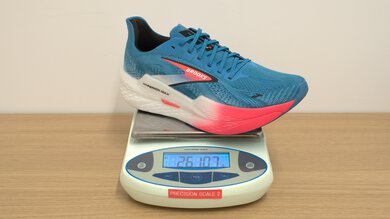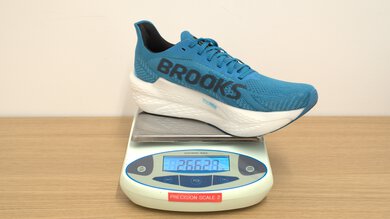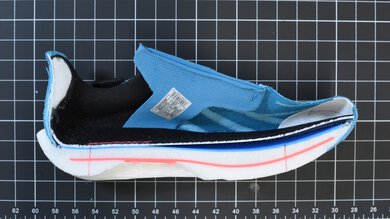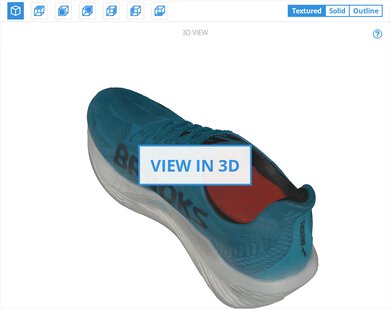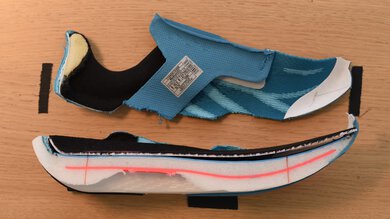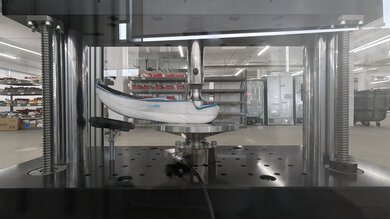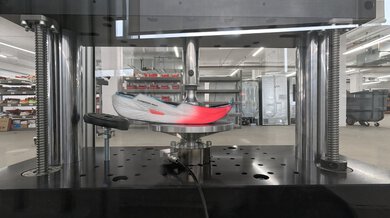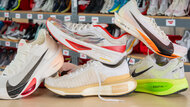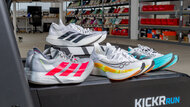The Brooks Hyperion Max 2 is a plated tempo trainer. It features a nylon ‘SpeedVault’ plate in the midsole and has a pronounced forefoot rocker that make it a good fit for speed training, though it isn’t the most lightweight shoe. Its moderately high-stack cushioning and breathable mesh upper make for a stable, comfortable ride.
Our Verdict
The Brooks Hyperion Max 2 is intended to be a trainer rather than a race day option, but it's best suited to training for moderate to longer distances. It offers a decently cushioned ride, though it isn't the most protective for high-performance racing. It's also overly heavy and lacks the responsiveness needed for efficient racing, though its rockered geometry helps with smoother transitions. The nylon plate also adds structure and stability to your distance efforts, where form can begin to break down.
-
Nylon plate adds stability.
-
Forefoot rocker.
-
Decent overall cushioning.
-
Energy return is a bit lacking for high efficiency.
-
Not the most impact absorption for longer efforts.
-
Heavy.
The Brooks Hyperion Max 2 isn't intended for racing at shorter distances. It's too heavy to really be efficient for races, and its energy return is only decent. However, its nylon plate adds some stiffness that makes for snappier transitions at faster paces.
-
Forefoot rocker.
-
Nylon plate adds stiffness.
-
Energy return is a bit lacking for high efficiency.
-
Heavy.
The Brooks Hyperion Max 2 has decent energy return. It's fairly responsive for a trainer, but it's not propulsive enough for high-performance efficiency.
-
Energy return is well-balanced across the heel and forefoot.
-
Energy return is a bit lacking for high efficiency.
The Brooks Hyperion Max 2 is decently cushioned. Though its forefoot doesn't absorb as much impact as its heel, it's fairly protected underfoot, if a bit less than ideal for very long runs.
-
Decent overall cushioning.
-
Not the most impact absorption for longer efforts.
The Brooks Hyperion Max 2 has very good lateral stability. Its relatively firm foam and nylon plate add stability to the midsole, and the shoe doesn't have an overly high stack height, giving it a more grounded feel. However, the outsole is slightly narrow in the heel.
-
Nylon plate adds stability.
-
Feels fairly firm underfoot.
-
Moderate stack height.
-
Narrow outsole heel.
- 6.9 Marathon Racing
- 7.4 5K/10K Racing
Performance Usages
- 7.1 Energy Return
- 7.0 Cushioning
- 7.9 Lateral Stability
Changelog
- Updated Apr 02, 2025: Converted to Test Bench 0.8.
- Updated Apr 02, 2025: Review published.
Check Price
Differences Between Sizes And Variants
We bought and tested the Brooks Hyperion Max 2 in men's US size 9 in the Crystal Seas/Diva Pink/Black colorway. Here's the label for our pair. Depending on your region, you can also buy the shoe in other colorways, including Illusion/Coral/Black, Cobalt/Green Gecko/Limpett, White/Peach/Coral, and Black/Gold/Pink.
This shoe is only available in standard width in men's and women's sizing.
Compared To Other Running Shoes
The Brooks Hyperion Max 2 is a plated daily trainer suited to up-tempo and longer runs. Despite the 'Max' in its name, it's not a maximalist shoe, with a moderate stack height and decent cushioning. Like other models in the Hyperion lineup, such as the lightweight, lower-stack Brooks Hyperion 2 and the more performance-oriented Brooks Hyperion Elite 4, it features a breathable mesh upper and is intended for faster paces. However, it's still heavier than other shoes in its class, and its nitrogen-infused DNA Flash v2 foam doesn't offer the most responsive ride compared to more performance-oriented foams on the market. While the Hyperion Max 2 tries to balance comfort and speed, lighter and more efficient plated trainers like the Saucony Endorphin Speed 4 outpace it in most areas, while higher-stack options like the ASICS SUPERBLAST 2 offer superior cushioning for long runs.
See the best running shoes we've tested to find the best shoe for your needs.
Despite sharing a 'max' moniker, the Brooks Glycerin Max and the Brooks Hyperion Max 2 are quite different models. The Glycerin Max is a maximalist high-stack daily trainer, while the Hyperion Max 2 is a plated super trainer. The Hyperion Max 2 is notably lighter, with a lower stack height that delivers a more stable and responsive ride that's better for training at faster paces. By contrast, the Glycerin Max offers more cushioning but lacks the bounciness needed for uptempo runs, making it a better fit for easier miles and recovery runs.
Both the Brooks Hyperion 2 and Brooks Hyperion Max 2 are intended for faster-paced workouts, but they approach that goal in different ways. The Hyperion 2 is a more traditional shoe with a lighter weight and lower stack height that makes it well-suited to faster and shorter runs. Meanwhile, the Hyperion Max 2 has a less traditional geometry and falls a bit more into the super trainer category, with a pronounced rocker and nylon plate. It's notably more cushioned than the Hyperion 2, making it the better option for longer efforts.
While they're both plated trainers, the Saucony Endorphin Speed 4 is better overall than the Brooks Hyperion Max 2. The Saucony is notably lighter and delivers better energy return thanks to its PEBA-based midsole, making it a bit more versatile and more efficient at faster paces.
The ASICS SUPERBLAST 2 is a better option for long runs than the Brooks Hyperion Max 2. It has significantly better cushioning and offers more underfoot protection. It's also a bit lighter. However, some may prefer the Brooks' lower stack and firmer foam, which offers a bit more stability.
The PUMA Deviate NITRO 3 and Brooks Hyperion Max 2 are both plated super trainers built to handle faster training sessions. The Puma has a carbon plate, which is superior for racing short distances. This plate offers a stiffer, more aggressive feel. The Hyperion Max 2, meanwhile, uses a nylon plate—less aggressive but paired with a midsole that provides greater energy return, offering a bouncier ride.
The Brooks Hyperion Max 2 and adidas Adizero Boston 13 are both plated super trainers with the ability to handle faster efforts, but they achieve it in different ways. The Hyperion Max 2 absorbs more energy with each foot strike, delivering a softer and more forgiving ride that's ideal for runners who want a shoe that can eat up long miles without feeling harsh. It also has a nylon plate, while the adidas features full-length ENERGYRODS that are stiffer. The Boston 13 is also lighter and has a more energetic midsole, making it the more efficient and lively option for runners looking to rip apart those uptempo workouts.
The Brooks Hyperion Max 2 and the adidas Adizero Boston 12 are both plated super trainers, but each has distinct strengths. The adidas features full-length carbon rods and a firmer forefoot, making it more snappy and better suited for shorter races. The Brooks, on the other hand, uses a nylon plate combined with a softer, more cushioned midsole, offering a more forgiving and comfortable ride for your interval sessions.
Test Results
The Brooks Hyperion Max 2 has decent energy return in the heel. However, its DNA Flash v2 foam doesn't deliver the bounciest experience, especially compared to more efficient plated trainers like the Saucony Endorphin Speed 4.
The forefoot provides similar energy return. While you won't get the most propulsive toe-offs out of it, it still returns enough energy for a fairly lively feel, especially for a trainer.
The heel is decently cushioned, offering especially effective impact absorption at higher forces. Overall, it offers a balanced level of cushioning, comfortable enough for longer runs without feeling overly plush.
The forefoot cushioning is okay as well, but it isn't quite as protective as the heel. It doesn't provide as much comfort for those who land higher up on the foot, but it's cushioned enough to prevent bottoming out.
The heel is fairly firm, providing some stability. Though the feel is softer at higher intensities, such as when picking up the pace or under heavier loads, it still offers a bit more firmness and stability at these intensities than other highly cushioned models like the Brooks Glycerin Max.
The forefoot is very firm, making it feel more stable and controlled. That said, if you prefer a softer feel under the forefoot, you might find it a bit harsh.
Check Price
Comments
Brooks Hyperion Max 2: Main Discussion
Let us know why you want us to review the product here, or encourage others to vote for this product.


